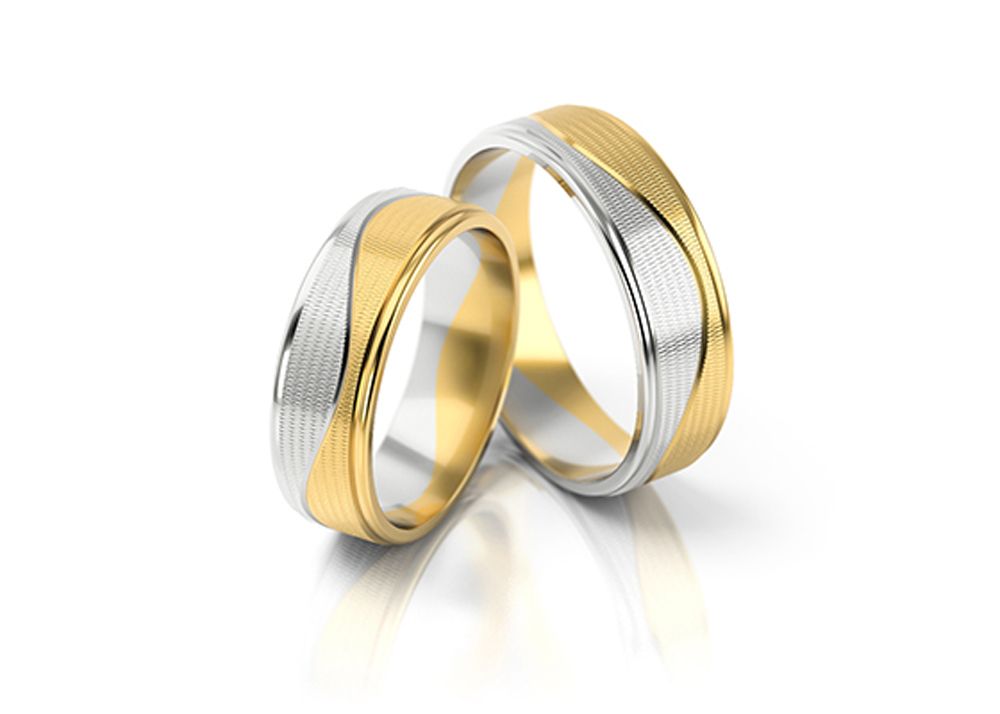
All About Wedding Ring Finishes and Surface Textures
For almost as long as people have been making beautiful objects out of gold, the hammer has been the goldsmith’s best friend. The relationship between artisans and their tools is part of what gives handcrafted works of art their aura: whether it’s a thousand-year old figure crafted in Colombia or a hammered-finish gold ring from the mid-20th century, seeing the hand of the artisan in the texture of the metal connects you to the physical labor that went into its creation. Textured metal makes it impossible to ignore the fact that this object in your hands was shaped by another pair of hands, and it’s been passed from theirs to yours.
The tools have changed over the years, but the dedication to craftsmanship remains. In addition to hammering the metal, we can use tools such as a ring polisher with brushes of different materials, coarseness, and textures to achieve different effects. Here’s how we create the various textures you see in the Design Center and our curated collections.
Polished: The classic. Platinum, palladium, and all of our gold, whether yellow, white, red, or peach, is beautiful on its own. If you appreciate the shine of precious metal, a polished surface is for you. Precious metals are corrosion and tarnish resistant, and will maintain that shine as long as they are re-polished periodically. There is one exception, however: platinum. Platinum will acquire a patina over time, in which the metal takes on a satiny appearance. This patina can be polished away, but some people love the look of platinum patina, as it signifies the passage of time. A platinum ring will grow and change with you.
Ice-Matte: A striking finish, literally and figuratively. To create this finish, we strike the ring with a sheet of sandpaper, creating lines and grooves in the ring. The irregular pattern gives the ring both the rough look and the mysterious soft glow of a vast mountain glacier.
Satin Cross Brush: In this finish, the brush is moved across the surface of the ring, creating a texture of lines that run perpendicular to the edges of the ring. This finish changes the way light reflects off of the ring, adding a sense of depth.
Soft Satin Brush: Like the satin cross brush finish, a soft satin finish adds a little bit of texture to the surface of the ring that changes the way light plays on its surface. Because the brush lines run vertically along the ring, the result is a softer glow than the more dramatic satin cross brush finish.
Sandblast: A sandblasted finish is exactly what it sounds like: the ring is blasted … We use either coarse or fine (large or small) grains of sand to create different effects. The coarse sandblast finish is much more textured. The effect is different for different types of metals. It looks quite luxurious and sophisticated in gold, but it gives platinum and palladium a much more rugged look.
Florentine: The Florentine finish is a delicate and precise pattern that takes a delicate and precise hand. Using a graver (a tool for shaving and engraving metal), the jeweler carves a series of angled lines across the face of the ring in one direction, then crosshatches it in the other direction. The intricate zig-zag pattern created gives the ring a soft glow from afar and a complex, sophisticated look up close.
Sandstone: Like the sandblast finish but even more coarse, the sandstone finish gives your ring a sparkling finish that makes it almost look like it is encrusted in gemstones.
Cross Brush: This finish is similar to the satin cross brush, but with a heavier brush. The result is a luxurious, satiny finish that looks like it would be soft or fluffy to the touch, especially when paired with a rounder ring profile.
Combining Cutting-Edge Tools With an Artisan’s Touch
These finishes aren’t a matter of turning on a machine and letting it do its thing. There is an interplay between the spinning brush and the ring that we have to feel out. It takes practice to know intuitively the right amount of pressure to apply and when to rotate the ring. And it takes patience and a steady hand to painstakingly carve out the pattern of a Florentine finish. Because of the interactions between artisans and our tools, the finished product is slightly different each time. There is a degree of consistency from one ring to the next, but no two are exactly alike.